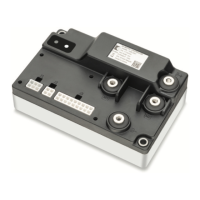6 — TUNING VEHICLE PERFORMANCE
Curtis Model 1226 – September 2019
Return to TOC
pg. 68
Step 4: Adjust IR Compensation
Use the IR Comp and Anti-Rollback Comp parameters to congure the motor resistance that the
controller applies to compensate for the following conditions:
• Increased load caused by uneven terrain. (IR Comp)
• e throttle is released to neutral and the vehicle speed is near zero. (Anti-Rollback Comp)
For details on these parameters, see Compensation Menu on page 53.
e values of both parameters are percentages of the System Resistance parameter. ese parameters
thus rely on the System Resistance parameter being set correctly; see page 64.
Conguring the IR Comp parameter involves a trade-o. When you increase the vehicle’s ability
to overcome load disturbances, the vehicle’s operating smoothness decreases, as described below:
• A properly set IR Comp value allows the vehicle to continue creeping at low speed if the
vehicle contacts a bump in a doorway’s threshold.
• However, if the IR Comp value is too high, the vehicle will be jumpy during normal driving.
Small throttle movements will no longer provide gentle linear acceleration, but instead
will initiate accelerations with a sharp jerk.
e tuning goal is to nd a balance between adequate load response and normal acceleration and
deceleration response.
e typical IR Comp range is 50%–80%. If you nd that you can only achieve acceptable performance
by setting IR Comp outside the 50%–80% range, the System Resistance parameter is probably
congured incorrectly.
Note: Signicant changes to the IR Comp value will aect the minimum and maximum speeds that
you previously set. If you make signicant changes to IR Comp, it is recommended that you repeat
the steps in this chapter.
e controller applies anti-rollback compensation just before the vehicle stops when the throttle is
released to neutral. Anti-Rollback Comp is typically set about 20% higher than IR Comp.
Table 30 provides guidelines for adjusting these parameters.
Table 30 IR Comp and Anti-Rollback Comp Guidelines
Issue Diagnosis
The vehicle is extremely jumpy. In other words, the vehicle
responds abruptly to small throttle changes.
IR Comp is probably set too high.
The vehicle speed varies dramatically when cresting a hill. IR Comp is probably set too low.
The vehicle rolls the other direction near the end of a stop
on at ground.
Anti-Rollback Comp is probably set too high.
The vehicle is still moving on a modest ramp when the
brake is applied.
Anti-Rollback Comp is probably set too low.
The vehicle seems to decelerate to a stop in a nonlinear
fashion.
Anti-Rollback Comp is probably set too high.

